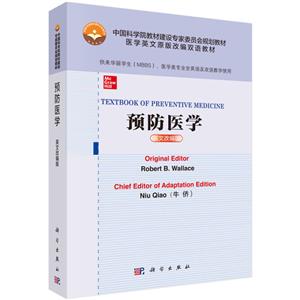-
>
中医基础理论
-
>
高校军事课教程
-
>
毛泽东思想和中国特色社会主义理论体系概论(2021年版)
-
>
中医内科学·全国中医药行业高等教育“十四五”规划教材
-
>
中医诊断学--新世纪第五版
-
>
中药学·全国中医药行业高等教育“十四五”规划教材
-
>
中医外科学——全国中医药行业高等教育“十四五”规划教材
预防医学:英文改编版 版权信息
- ISBN:9787030657701
- 条形码:9787030657701 ; 978-7-03-065770-1
- 装帧:一般胶版纸
- 册数:暂无
- 重量:暂无
- 所属分类:>>
预防医学:英文改编版 本书特色
适读人群 :中国医学生和在中国学习的外国学生国内**套改编自经典英文原版的医学教材,语言纯正,并保留原书图文并茂的特色,低价满足国内医药教育需求 知名院士及资深教授参与改编,国外专家审定 内容和编排与教育部教学指导方案及全国规划教材一致,符合国内教学实际 适合双语教学,与国际医学教育接轨既吸收原版教材之精华,又融入国内教材之经典,并有创新发展 供高等院校医学类本科、长学制、研究生、留学生双语及全英文教学中用。 为配合教师教学,部分课程可提供相关配套资料
预防医学:英文改编版 内容简介
Maxcy-Rosenau-Lastpublichealth&preventivemedicine自1913年首次出版以来已有百年历史。《TEXTBOOK OF PREVENTIVE MEDICINE 预防医学(英文改编版)》不仅涵盖了20世纪公共卫生与预防医学的大量知识,而且还包含了21世纪以来的新进展。我们发现,在每一次修订时选择恰当的内容变得越来越困难。传统的公共卫生与预防医学问题仍然存在,公共卫生与预防医学领域新的知识、研究成果和实践信息日新月异,新发疾病的出现也在不断更新和拓展我们的知识构架;新发微生物带来的重要公共卫生学意义已经凸显;行为科学在健康促进、卫生行为规范和健康宣教中发挥越来越重要的作用;新材料、新化学物和新技术的出现,在带来科技的进步的同时也造成了职业环境和其他环境的污染;预期寿命的延长使得退行性疾病预防、综合的医疗保健计划和其他疾病预防变得越来越重要;对于人口增长和生态脆弱可能导致的公共卫生困境还不能完全预期;同时,低出生率和人口老龄化正在挑战当前的公共卫生和预防医学体系。人类冲突目前也成为一个公共卫生问题,社会和“非自然因素”在其中所起的作用越来越受到人们的关注;加强公共卫生实践和临床卫生服务的融合应该受到更多的重视。
本改写版在McGraw-Hill Education出版的第15版Maxcy-Rosenau-Last public health & preventive medicine的基础上完成,我们尽一切努力更新信息,获取新知识。
预防医学:英文改编版 目录
PART Ⅰ PUBLIC HEALTH PRINCIPLES AND METHODS 1
Chapter 1 Public Health and Preventive Medicine: Trends and Guideposts 1
SECTION 1 Increased incorporation of business and administrative practices into prevention and public health service delivery 1
SECTION 2 Changes in the definition of the group or population, the fundamental unit of public health 2
SECTION 3 Enhanced conceptualization and measurement of personal health status 2
SECTION 4 Increased codification and interpretation of scientific findings relevant to prevention and public health 2
SECTION 5 Establishment of goals for communities to attain improvement in health status 2
Chapter 2 Epidemiology and Public Health 4
SECTION 1 History 4
SECTION 2 Definition 5
SECTION 3 Foundations of epidemiological practice 9
SECTION 4 Surveillance 10
SECTION 5 Investigation 17
SECTION 6 Analysis 23
SECTION 7 Evaluation 29
SECTION 8 Applying epidemiology to public health 30
Chapter 3 Public Health Informatics 32
SECTION 1 Historical context 32
SECTION 2 Public health system needs for informatics 33
SECTION 3 Enterprise architecture and data interchange 33
SECTION 4 Public health worker needs 34
SECTION 5 Public health information system needs 34
SECTION 6 Medical care information system needs 36
SECTION 7 National health information system initiatives 36
SECTION 8 Lessons learned in developing health information systems to date 37
SECTION 9 Challenges for the future—implications for public health informatics 38
Chapter 4 Genetic Determinants of Disease and Genetics in Public Health 40
SECTION 1 Genes in populations 41
SECTION 2 Incidence and prevalence of genetic disease 43
SECTION 3 Categories of genetic disease 44
SECTION 4 The human gene map and gene sequencing 47
SECTION 5 Evidence for clustering in families 48
SECTION 6 Screening, prenatal diagnosis and genetic services 50
SECTION 7 Summary and conclusions 54
PART Ⅱ COMMUNICABLE AND NONCOMMUNICABLE DISEASES 55
Chapter 5 Communicable Diseases 55
SECTION 1 Control of communicable diseases 55
SECTION 2 Diseases controlled primarily by vaccination 61
SECTION 3 Epidemiology and trends in sexually transmitted infections 67
SECTION 4 The epidemiology and prevention of human immunodeficiency virus (HIV) infection and acquired immunodeficiency syndrome (AIDS) 72
SECTION 5 Infection spread by close personal contact 77
SECTION 6 Diseases spread by food and water 98
SECTION 7 Diseases transmitted primarily from animals to humans (ZOONOSES) 102
SECTION 8 Control of infections in institutions: health care-associated infections 108
Chapter 6 Noncommunicable and Chronic Disabling Conditions 113
SECTION 1 Screening for early and asymptomatic conditions 113
SECTION 2 Cancer 115
SECTION 3 Heart disease 127
SECTION 4 Diabetes 142
SECTION 5 Nutrition in public health and preventive medicine 152
PART Ⅲ ENVIRONMENTAL HEALTH 162
Chapter 7 Toxicology 162
SECTION 1 Branches of toxicology 162
SECTION 2 Toxic agents and toxicology 163
SECTION 3 Chemicals in the environment 165
SECTION 4 Exposure to toxic substances and change in the body 166
SECTION 5 Acute and chronic exposure and toxicity 170
SECTION 6 Toxicological effects and pharmacodynamics 171
SECTION 7 Mechanisms of toxicity 173
SECTION 8 Carcinogenesis: initiation and promotion 177
SECTION 9 Mixtures and interactions 178
SECTION 10 Clinical evaluation of toxicity 179
SECTION 11 Biomarkers 179
SECTION 12 Causality: environmental chemical exposure and health effects 181
SECTION 13 Toxicity testing 182
SECTION 14 Animal welfare and animal rights 182
SECTION 15 Measures to reduce toxicity hazards 183
SECTION 16 Future directions 184
SECTION 17 Old directions 185
Chapter 8 Pneumoconiosis 186
SECTION 1 Asbestos-associated diseases 186
SECTION 2 Coal workers’ lung disease 193
SECTION 3 Silicosis 197
Chapter 9 Health Significance of Metal Exposures 205
SECTION 1 Aluminum 206
SECTION 2 Antimony 208
SECTION 3 Arsenic 208
SECTION 4 Beryllium 210
SECTION 5 Cadmium 210
SECTION 6 Chromium 212
SECTION 7 Cobalt 213
SECTION 8 Copper 214
SECTION 9 Iron 214
SECTION 10 Lead 215
SECTION 11 Manganese 217
SECTION 12 Mercury 218
SECTION 13 Molybdenum 221
SECTION 14 Nickel 221
SECTION 15 Selenium 222
SECTION 16 Thallium 223
SECTION 17 Tin 224
SECTION 18 Uranium 224
SECTION 19 Vanadium 225
SECTION 20 Zinc 225
Chapter 10 Disease Associated with Exposure to Chemical Substances: Organic Compound 227
SECTION 1 Organic solvents 227
SECTION 2 Aromatic nitro- and amino-compounds 247
Chapter 11 Pulmonary Responses to Gases and Particles 250
SECTION 1 Functional zones of human lung 250
SECTION 2 Occupational polluted air 251
SECTION 3 Environmental air pollution 258
SECTION 4 Indoor air pollution 260
C
- >
伊索寓言-世界文学名著典藏-全译本
伊索寓言-世界文学名著典藏-全译本
¥6.1¥19.0 - >
【精装绘本】画给孩子的中国神话
【精装绘本】画给孩子的中国神话
¥20.9¥55.0 - >
诗经-先民的歌唱
诗经-先民的歌唱
¥15.1¥39.8 - >
名家带你读鲁迅:朝花夕拾
名家带你读鲁迅:朝花夕拾
¥14.3¥21.0 - >
苦雨斋序跋文-周作人自编集
苦雨斋序跋文-周作人自编集
¥6.9¥16.0 - >
史学评论
史学评论
¥18.5¥42.0 - >
龙榆生:词曲概论/大家小书
龙榆生:词曲概论/大家小书
¥9.1¥24.0 - >
朝闻道
朝闻道
¥20.2¥23.8
-
中医基础理论
¥40.6¥58 -
儿童保健学(第4版)/毛萌/本科儿科(配增值)
¥63.5¥69 -
全科医学案例解析
¥40.6¥58 -
全科医生临床实践-第2版
¥100.3¥118 -
流行病学学习指导与习题集-第3版
¥28.8¥36 -
中医妇科学
¥75.7¥88



















